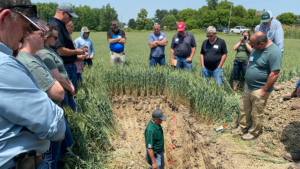Weed control for 2024
ENSURE THE BEST OUTCOMES NEXT YEAR

EVERY FALL, ALONG with combining, grain storage, and other harvest tasks, weed control for the coming season should be top of mind.
| WHAT YOU NEED TO KNOW • Group 14-resistant common ragweed has been identified in several areas of the province, and their populations are growing. • Cover crops can help minimize the impact of common ragweed and other weeds. • Planting oats or cereal rye after soybeans can help reduce ragweed as they emerge early and compete well. • Waterhemp resistance has also been found in Ontario. • A fall or super-early spring application of herbicides can effectively control perennials like bluegrass, rye grass, or brome grass in corn and winter wheat. |
Don McLean, strategic agronomy marketing manager at GROWMARK, notes that resistance issues remain serious in Ontario. Common ragweed, with its multiple group resistances — especially Group 14 — is a particular problem among growers of Identity-Preserved soybeans.
Mike Cowbrough, field crop weed specialist at the Ontario Ministry of Agriculture, Food and Rural Affairs, confirms that Group 14-resistant common ragweed has been identified in several areas of the province and that these populations are growing. “The most-effective herbicides for this weed are Reflex and Blazer, but they are both Group 14, which means there are no options, and there’s nothing coming down the pipeline that I’ve heard of,” Cowbrough says.
What can growers do? “First of all, we are asking all growers to send samples of common ragweed that have escaped herbicide application in soybeans and dry beans to please send it for no-cost resistance testing,” notes Cowbrough. “In terms of preventing seed production, harvest weed seed destructors may be an option, but ragweed often disperses its seed before harvest. There are four or five Weed Zappers in the province, and they’re effective at stopping weed seed production, but the ragweed obviously has to be above the crop canopy for this to work. This approach does help with numbers for the following year, but doesn’t solve the problem of competition during the critical period of weed control.”
COVER CROPS CAN HELP
However, cover crops and tillage are very good options for resistant common ragweed, along with many other weeds. Cowbrough recommends oats or cereal rye after soybeans because they emerge early and compete well with common ragweed and other early-emerging species. However, he acknowledges that growers with clay soils generally have to delay killing cereal rye off in the spring, which is difficult at that point due to the large size. Oats are a good option as they die by spring, and the residue is not excessive. Cowbrough says oat seed rates as low as 50 lbs/ac work well and that the seed can be blended with potash. Growers may also be able to get revenue from baleage in the fall from oats.
James Ferrier, agronomist and product development manager at Nufarm, notes that research into rye, oats and other cover crops in terms of weed suppression is now extensive. “I have had success on my farm with an oat cover crop combined with light tillage after winter wheat to disrupt some weed species’ life cycles,” he says.
Cowbrough reports that about a million acres in Ontario are still left uncovered every winter. If growers can try some type of cover crop on that acreage, it will go a long way to help with overall weed control over time. “The more we can do to reduce the number of seeds returning to the soil, the better,” he says. “It’s a numbers game.”
WATERHEMP
Cover crops also help with waterhemp, along with diverse rotations, according to new research by University of Guelph Ridgetown Campus scientists. At present, there is waterhemp present in Ontario that is resistant to several modes of action.
For this weed, Cowbrough advises growers to scout thoroughly (any weird-looking pigweed should be checked to see if it is waterhemp, then sent for resistance testing). Any fields with waterhemp present this year must have soil-applied herbicides applied next year if you are going into corn and soybeans, as they are the backbone of effective waterhemp management. He strongly urges growers to scout and deal with any they see before the population grows exponentially.
He adds that planting cover crops is the most logical route for growers not planting winter wheat after soybean harvest. “Of course, there is also plenty of opportunity to do it after wheat,” notes Cowbrough. “And after corn that’s silage corn or taken off early, we have seen lots of growers plant cover crops and get the benefits in the spring. It’s riskier to get establishment after grain corn, so try it on a small scale, experiment with it and scale it up. Besides weed suppression, it also reduces erosion. And when conditions after herbicide application are dry, and the risk of herbicide carryover is greater, cover crops can help alleviate the risk to some extent.”
FALL APPLICATION
Ferrier notes that while some farmers have been doing fall or post-harvest burndown herbicide application after winter wheat or soybean harvest for many years, new research showing its value may prompt more to try it. “The goal is to target weeds that emerged late in the current crop and to clean up the field for planting fall cereal crops,” he says. “Weeds are easiest to control when small and actively growing, and many perennial and winter annual weeds are smallest and easiest to control in the fall.”
In addition, weeds like Canada fleabane are easy to control in the fall but display variable control in the spring. Higher yields are also a result of fall herbicide application, says Ferrier. “We know that fall weed interference pulls yield from fall-seeded crops. In four winter wheat trials in 2020-2021, our Nufarm research program showed an average of 12 bu/ac gained by implementing a fall herbicide program over not spraying. I know that most growers would have still sprayed in the spring, but this demonstrates the magnitude of yield loss due to weeds in winter wheat.”
He adds that researchers like Dr. Eric Johnson have demonstrated that a fall herbicide application containing pyroxasulfone (Fierce, Zidua) before planting winter wheat could provide over 80 per cent control of grasses the following season.
Cowbrough agrees that a fall or super-early spring application of herbicides effectively controls perennials like bluegrass, rye grass, or brome grass in corn and winter wheat. “Tillage should also be examined as a control method, and again, cover crops,” he says. “This problem is coming from tight rotations, and we’re seeing more of it, and I feel like in some areas we’re at a tipping point. Please consider fall herbicide, tillage and seed cover crops.”
FOR MORE
Find out more, including a common ragweed resistance map along with details for resistance testing and an overview of integrated pest management strategies, which Cowbrough notes apply to most weeds at https://fieldcropnews.com/2017/10/common-ragweed-biology-and-control/. •

























